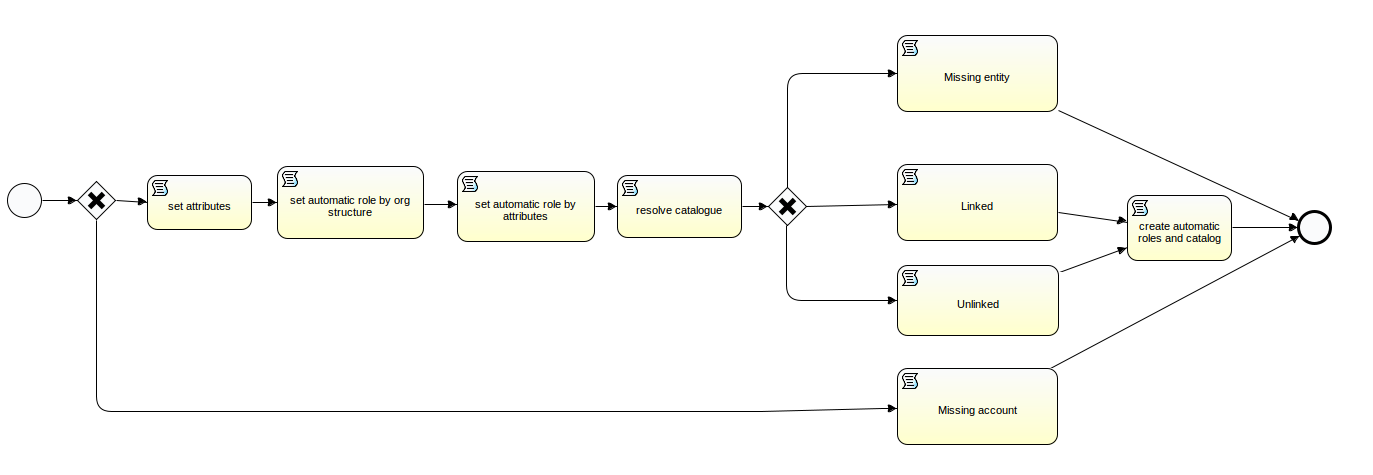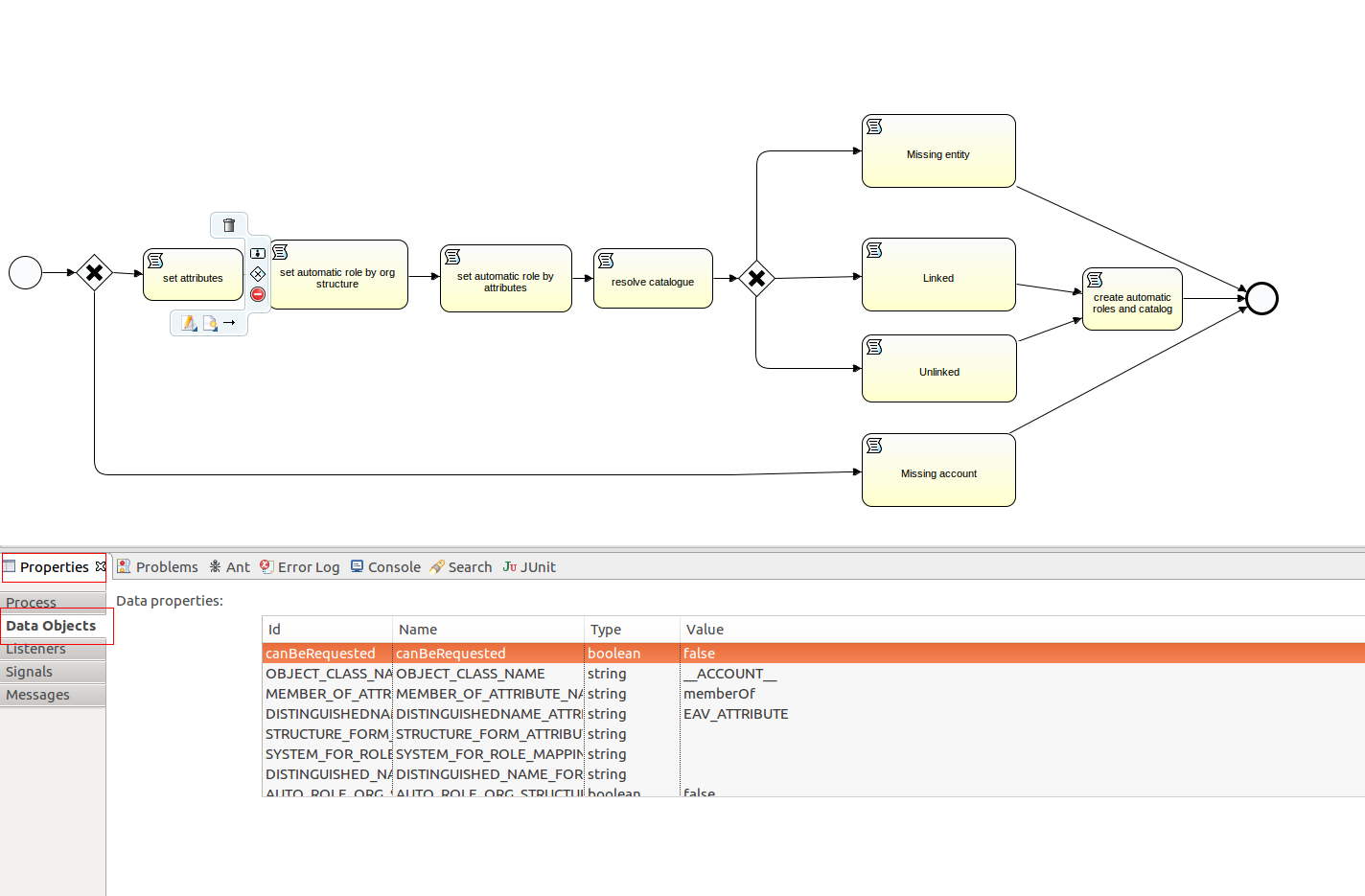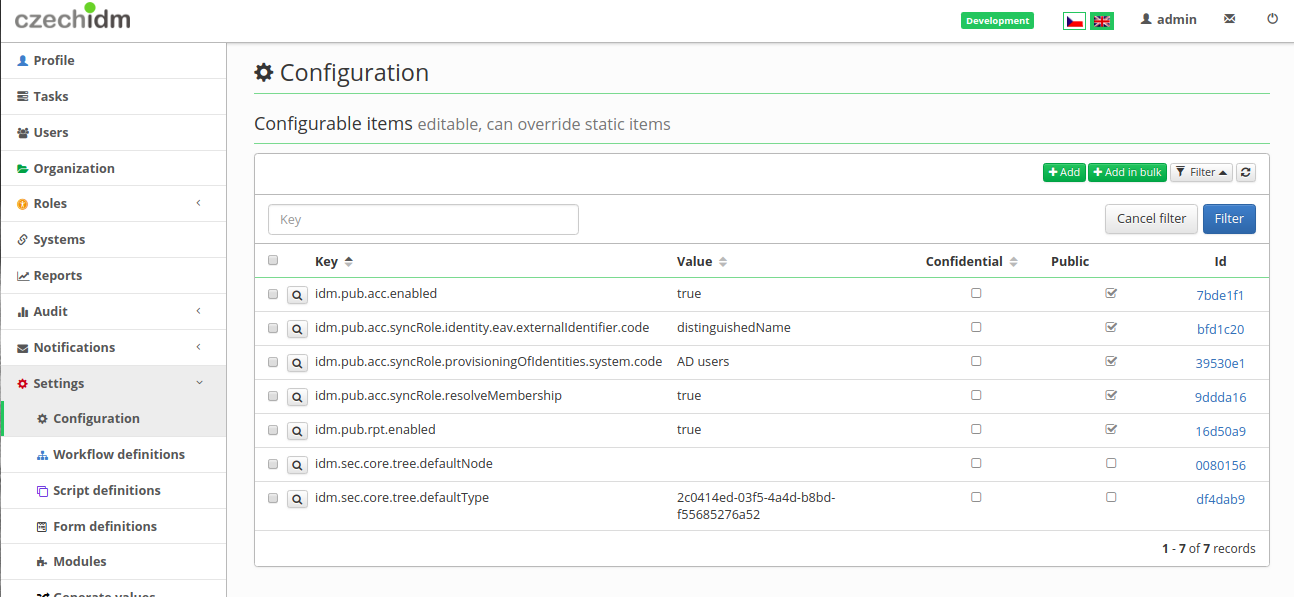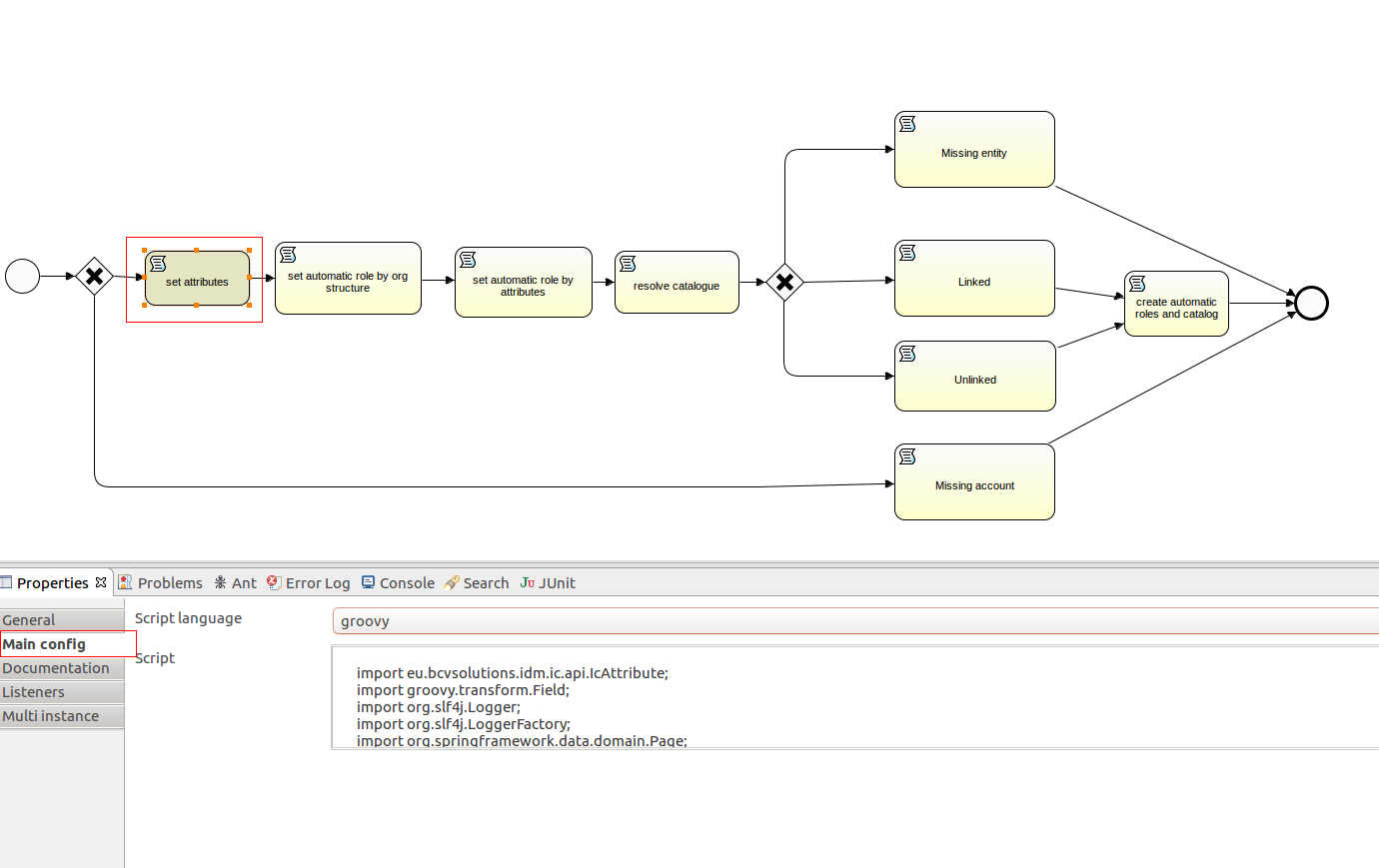Systems - Groups synchronization workflow
Before you start
In this tutorial we will be using Eclipse and Activiti framework.
Workflow
For synchronization groups from AD, we have prepared workflow "syncRoleLdap.bpmn20.xml"
The workflow has modified these actions:
- Linked/update entity
- Missing entity/create entity
- Unlinked/create link and update entity.
Workflow is divided into 9 activities, but only the first four activities are mainly to be modified.
Data Objects
First of all is crucial to set data objects in Data Objects tab.
- STRUCTURE_FORM_ATTRIBUTE - code of eav of organization tree node. It is used to add an automatic role by organization structure. And every organization structure should have an eav with some value to determine, which role will have an automatic role on which tree node.
- CODE_OF_TYPE_STRUCTURE - code of structure, this define which organization tree will be used for searching/creating automatic roles for organization structure. Default value means default organization tree.
- AUTO_ROLE_ORG_STRUCTURE_ENABLED - if false, automatic roles by attribute methods are skipped.
- AUTO_ROLE_ATTRIBUTES_ENABLED - if false, automatic roles by organization structure methods are skipped.
Set aplication properties
Workflow was updated and now you can just add properties to aplication and you do not have to anyhow change workflow file. Aplication property are specified in Settings agenda in Configuration tab (like you can see on picture bellow).
With button Add you can add any property described bellow and configure workflow.
- idm.pub.acc.syncRole.role.canBeRequested - (true/false, default: false) - sets to all roles, if the role can be requested by identity
- idm.pub.acc.syncRole.role.update.manageCanBeRequested - (true/false, default: false) - enable/disable setting can-be-requested role attribute
- idm.pub.acc.syncRole.system.mapping.objectClassName - (default: __ACCOUNT__) this is important to provisioning member attribute of identity. It is an object class name of identity schema. It supposedly can stay as "__ACCOUNT__"
- idm.pub.acc.syncRole.system.mapping.attributeMemberOf - (default: ldapGroups) - it is the name of an attribute in a mapping of identity provisioning. It is usually memberOf or ldapGroup. This attribute will be added to role's mapping with tramsformation script (which will be set later). -
- idm.pub.acc.syncRole.system.mapping.attributeRoleIdentificator - (default: distinguishedName) - the name of an attribute in the connector, which holds the distinguished name of a role.
- idm.pub.acc.syncRole.provisioningOfIdentities.system.code - (default: null, mandatory) - it is code (name) of the system, where identities have provisioning.It is now mandatory attribute, otherwise workflow will not be working.
- idm.pub.acc.syncRole.identity.eav.externalIdentifier.code - (default: null) - code of eav of a distinguished name of identities. it is used in creating entity in the situation of a Missing entity. It is important when groups in AD already have members and some of the identities DNs cannot be calculated again.
- idm.pub.acc.syncRole.roleCatalog.ResolveCatalog - (true/false, default: true) - This property will disable creating of catalogue.
- idm.pub.acc.syncRole.update.resolveMembership - (true/false, default: false) - With this property you can turn on resolving memberships of roles even in other situation than creating role. This is usually used, when connecting system for synchronization of roles, when you forgot configure 'externalIdentifier'.
- idm.pub.acc.syncRole.roles.allToOneCatalog - (default: null) - Add name of catalog. all roles will be added to this 'folder'
- idm.pub.acc.syncRole.roles.attributeNameOfMembership - (default: member) - it is name of attribute of role in source system, which holds identificators of identities
- idm.pub.acc.syncRole.roleCatalog.catalogueTreeInOneCatalog - (default: null) - if creating of catalog like DN is enabled, this property will create tree of catalogues under root catalog. Name of this root catalog set in this property. Catalogue folder have to and will be created in workflow process. If this property will be changed, new catalog folder will be created. Name of catalogues can be changed in IdM.
- idm.pub.acc.syncRole.roleSystem.forwardManagement.value - (default: false) - When role is created with connected system and it manages membership. In this case there is option 'forward management'. This property will set this option.
- idm.pub.acc.syncRole.roleSystem.update.manageforwardManagement - (default: false) - This property will manage 'forward management' option even on update roles.
- idm.pub.acc.syncRole.roles.nameOfRoles.doNotSentValueOnExclusion - (default: null) - On role create with connected system and system attribute, there is option, this attribute will be skipped on excluded contract. Add to this property names of roles separeted with comma. (does not work with roles, which has comma in name)
- idm.pub.acc.syncRole.roles.update.nameOfRoles.manageSentValueOnExclusion - (default: false) - This property will manage skip of attribute option even on update roles.
- idm.pub.acc.syncRole.roles.create.priorityOfRoles - (default: null, values: 1,2,3,4) - This property will set priority of roles, on this autorization workflow will be changed. Only on create.
- idm.pub.acc.syncRole.roles.create.garanteeOfRoles - (default: null) - Fiil in name of role, which will become garantee of all Ldap/AD roles. Only on create.
Since Extras version 1.8.0 you can use two new options which will help with following use case: I have more then 1 AD system connected as group source. Now the workflow has "global" configuration via application properties so I am not able to run scheduled synchronization and put group from one AD to catalog "one" and from second AD to catalog "two" and similar issue is with mapped systems.
This changes are backward compatible because if you don't set these new properties the WF behavior is same as in previous version.
If you set this property then the new behavior will be turned on.
- idm.pub.acc.syncRole.roles.catalogByCodeList - UUID of code list for catalogs for each system. Item in code list has UUID of source system and as value they have code of role catalog
- idm.pub.acc.syncRole.provisioningOfIdentities.codeList - UUID of code list for mapped sysmtes for each system. Item in code list has UUID value of AD group system which is used for synchronization and as value UUID of AD system which is used for user provisioning
Set attributes activity
This activity is to get some attributes from icAttributes as name and distinguished name. You can get another if they will be needed in the following activities. And also there is setted attribute:
execution.setVariable("TRANSFORMATION_SCRIPT", "\""+distinguishedName+"\"");
value of this attribute will be used as transformation script. (It will be used for provisioning of member attribute of identities).
Set automatic role by org structure
In this script, it is crucial to determine for a role to find tree node (organization) to create an automatic role by organization structure and set it to a variable like:
execution.setVariable("organizationTreeNode", pomList.get(0));
This script can be just slightly changed to work perfectly fine. In the default state, it is searching for a tree node, which has a name of the role in eav. In a previous activity, we can get even another attribute and with substring, it should be enough.
Set automatic role by attributes
This part is to create attributes for an automatic role. There can be more attributes, but only for identity/contract attributes or identity/contract eavs. You should create attributes (by default algorithm) put them into the field and lastly into "automaticAttributes" variable.
Resolve catalogue
This part is about Roles catalog. There are two methods. The first method creates catalog based on the Distinguished name of the role. The rightmost value of OU is a root of the catalog and then other OUs from the right are represented as folders and roles are assigned in the leftmost OU/catalog.
The other method is for removing folders of a catalog, if a role is transferred to another catalog, find the old one and set it in "catalogue" variable, and it will be erased.



